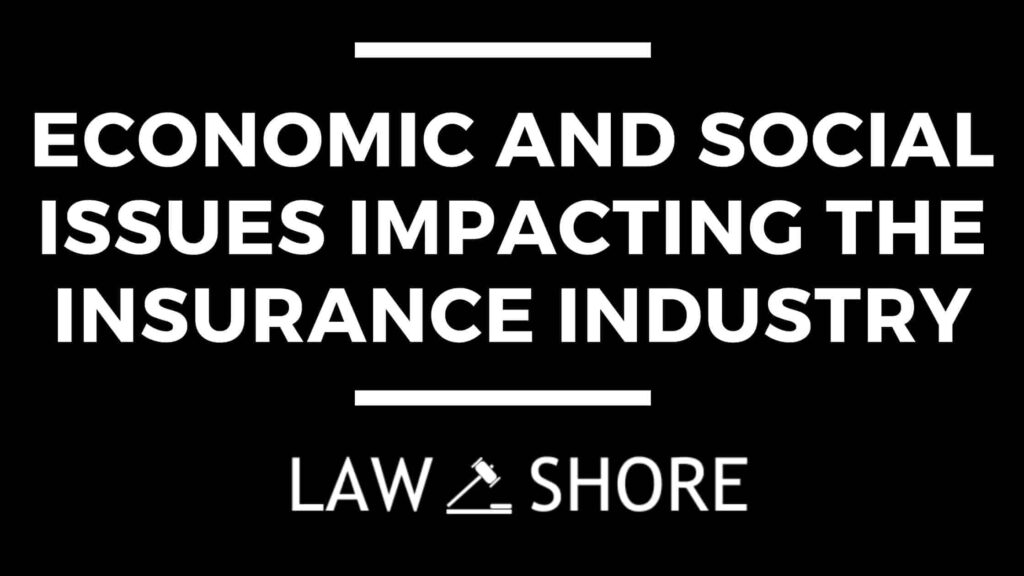Economic and Social Issues Impacting the Insurance Industry
Table of Contents
ToggleThe insurance industry is a fundamental pillar of the global economy, providing crucial financial protection for individuals, businesses, and governments against various risks such as health, life, property, and liability. As the world continues to evolve, several economic and social issues impact both the supply (insurers) and demand (consumers) sides of the insurance market. These factors can influence profitability, sustainability, and growth prospects for insurance companies. Below, we delve deeper into these challenges, examining their effects on the insurance sector while also discussing government initiatives, relevant case laws, and the growing need for innovation.

Economic Issues Impacting the Insurance Industry
Interest Rate Environment
Low/Negative Interest Rates:
Insurers typically rely on investment income generated from premiums they collect, which are then invested in financial instruments such as bonds and stocks. In an environment of low or negative interest rates, the returns from these investments diminish significantly, reducing the profitability of insurance companies.
For example, insurers may struggle to meet their long-term liabilities such as annuity payments or pension obligations, which are directly influenced by investment returns.
Impact:
- Reduced profitability from investment income.
Need for insurers to adjust pricing models to compensate for lower investment returns. - Long-term sustainability concerns, particularly in life and pension insurance sectors.
Inflation and Inflation Risk:
Inflation erodes the real value of both insurance claims and premiums, posing a challenge for insurers in pricing policies accurately. The growing inflationary environment, particularly after events like the COVID-19 pandemic, has made it more difficult to predict future claims. Long-tail liabilities such as life insurance, annuities, and disability benefits are particularly vulnerable to inflation.
Impact:
- Increased claims due to the rising costs of healthcare, medical treatments, and long-term care.
- Difficulty in pricing long-term insurance products like life insurance and annuities.
Possible adjustments to coverage limits and premium increases to mitigate inflation risks.
2. Capital and Liquidity Challenges
Underwriting Losses:
Insurers face significant liquidity challenges when underwriting losses persist over extended periods. This situation arises when the claims paid out exceed the premiums received. Unexpected catastrophic events such as natural disasters, pandemics, or geopolitical instability can lead to higher-than-expected claims, putting immense pressure on insurers’ capital reserves.
Impact:
- Potential liquidity crises leading to insolvency or the need for bailouts.
- Increased reliance on reinsurance or capital markets to manage risk.
Regulatory Capital Requirements:
Regulatory frameworks such as Solvency II in the European Union and the Risk-Based Capital (RBC) framework in the United States require insurers to maintain a certain level of solvency capital to ensure they can meet policyholder obligations. These stringent capital requirements can limit insurers’ ability to take on new risks or invest in innovative products and services.
Impact:
- Reduced ability to expand product offerings and enter new markets.
- Increased operational costs associated with regulatory compliance.
Reinsurance Market Volatility
The reinsurance market plays a crucial role in transferring risk from primary insurers to other entities. However, this market is highly susceptible to fluctuations caused by natural disasters, economic downturns, or geopolitical tensions. Price increases in reinsurance premiums often result in higher prices for consumers or reduced coverage by insurers.
Impact:
- Higher insurance premiums for consumers.
- Potential reduction in available coverage or withdrawal of insurers from high-risk areas.
Globalization and Economic Uncertainty
Global Interconnectedness:
Events such as the COVID-19 pandemic, geopolitical instability, and financial crises highlight the systemic risks that globalization can exacerbate. A catastrophe in one region can quickly affect global markets, posing challenges for international insurers and reinsurers.
Impact:
- Increased risk exposure due to interconnected global supply chains.
- Fluctuating investment returns due to volatile markets.
Exchange Rate Volatility:
Multinational insurers face the risk of currency fluctuations, which can affect their profitability, particularly when reinsurance contracts or foreign investments are denominated in foreign currencies.
Impact:
- Financial instability due to currency exchange losses.
- Increased cost of doing business in foreign markets.
Technology and Innovation
InsurTech:
The rise of InsurTech companies has transformed the insurance landscape. These tech-driven companies are introducing digital-first platforms, on-demand insurance, and AI-driven underwriting models. While this innovation offers growth potential, it also creates economic pressures on traditional insurers to adopt new technologies and remain competitive.
Impact:
- Increased competition, particularly from start-ups and digital-first companies.
- Substantial investment required in technology infrastructure to remain relevant.
Cybersecurity:
As insurers increasingly operate in the digital realm, cybersecurity has become a significant concern. Data breaches, hacking incidents, and the growing threat of cyber-attacks necessitate ongoing investment in cybersecurity infrastructure.
Impact:
- Rising costs related to securing digital platforms and managing data risks.
- Potential for increased cyber insurance claims, leading to higher premiums.
Social Issues Impacting the Insurance Industry
Aging Population
Increased Demand for Life and Health Insurance:
With an aging population, especially in developed nations, the demand for life insurance, long-term care insurance, and annuities is growing. While this presents a business opportunity, it also introduces significant risks, as older policyholders typically require more expensive care and treatment.
Impact:
- Higher claims related to health care, disability, and long-term care.
- Need for insurers to develop new products and services catering to an aging population.
Long-Term Care Insurance:
Longer life expectancies and advancements in medical technology have significantly increased the demand for long-term care insurance. However, these policies are often underpriced, and insurers may face mounting claims.
Impact:
- Pressure on insurers to recalibrate pricing and underwriting models for long-term care insurance.
- Possible financial strain due to higher-than-expected claims.
Income Inequality
Access to Insurance:
In societies with significant income inequality, lower-income individuals may struggle to afford insurance, leaving them vulnerable to unexpected risks. This social divide creates challenges for insurers in expanding their customer base and ensuring that all segments of society are covered.
Impact:
- Lower insurance penetration in lower-income segments.
- Increased risk of underinsurance, leaving consumers financially exposed.
Underinsurance:
Many individuals may opt for inadequate coverage due to financial constraints, which can lead to underfunded claims for insurers. In the long term, this undermines the sustainability of the insurance model.
Impact:
- Higher-than-expected claims due to underinsurance.
- Difficulty in accurately pricing policies for at-risk groups.
Social Awareness and Changing Consumer Expectations
Consumer Trust:
Trust remains a significant issue in the insurance industry, as many consumers perceive insurers as difficult to deal with, especially in claims settlement. Addressing these concerns is critical for insurers to retain and attract customers.
Impact:
- Insurers must invest in customer service, transparency, and clear communication.
- Increased demand for straightforward, user-friendly policies.
Social Responsibility (ESG):
With growing awareness around Environmental, Social, and Governance (ESG) issues, consumers are increasingly interested in working with socially responsible companies. This shift is influencing product offerings, with insurers introducing green policies and aligning their business practices with sustainability goals.
Impact:
- Insurers must integrate ESG factors into their operations to stay competitive.
- Rising demand for insurance products that are ethically sound and environmentally friendly.
Health Crises and Public Health
Pandemics and Health Crises:
The COVID-19 pandemic illustrated how global health crises can impact the insurance industry. Insurers were faced with rising health claims, while simultaneously experiencing operational challenges due to lockdowns and travel restrictions. This has prompted many insurers to rethink policy terms and coverage in light of global health risks.
Impact:
- Increase in health and life insurance claims.
- Rethinking of policy structures to account for future pandemics.
Mental Health:
Mental health has emerged as a major concern in the insurance industry, with an increasing number of claims related to mental health disorders. This has led insurers to reassess how mental health coverage is structured within health and life policies.
Impact:
- Rising claims and the need for better risk management strategies.
- Recalibration of insurance policies to provide adequate coverage for mental health conditions.
Climate Change and Natural Disasters
Increased Frequency of Natural Disasters:
Climate change has led to a rise in the frequency and severity of natural disasters such as floods, wildfires, and hurricanes. This has resulted in higher claims in property and casualty insurance.
Impact:
- Insurers face increasing challenges in pricing and covering catastrophic risks.
- Potential for insurers to withdraw from high-risk markets or reduce coverage.
Government Schemes in India
In India, the government has introduced several schemes to enhance the reach of insurance products, particularly focusing on underserved and rural areas. These initiatives aim to provide financial protection to economically vulnerable sections of society, improve financial inclusion, and promote the widespread adoption of insurance. Some of the key government schemes include:
Pradhan Mantri Jan Dhan Yojana (PMJDY)
Launched: 2014
Objective: To provide universal access to banking facilities, including insurance, to the unbanked and underserved populations, particularly in rural areas.
Key Features:
- Insurance Coverage: Under the PMJDY, account holders are provided with life insurance and accident insurance benefits. The Pradhan Mantri Suraksha Bima Yojana (PMSBY) and Pradhan Mantri Jeevan Jyoti Bima Yojana (PMJJBY) are linked to PMJDY accounts.
- Financial Inclusion: The scheme aims to provide financial services such as savings accounts, credit, and insurance to millions of previously excluded individuals.
- Target Group: Low-income households and the unbanked population across India, particularly in rural and semi-urban areas.
Pradhan Mantri Suraksha Bima Yojana (PMSBY)
Launched: 2015
Objective: To offer a low-cost personal accident insurance scheme to individuals, particularly for the poor and underprivileged.
Key Features:
- Coverage: The scheme provides a risk cover of ₹2 lakh in case of accidental death or total disability, and ₹1 lakh for partial disability.
- Premium: The premium is ₹12 per annum, making it highly affordable for individuals in low-income groups.
- Eligibility: Available to all individuals between the ages of 18 and 70 with a bank account. The insurance is auto-renewable every year.
Target Group: Primarily designed for the economically disadvantaged and rural populations.
Pradhan Mantri Jeevan Jyoti Bima Yojana (PMJJBY)
Launched: 2015
Objective: To provide affordable life insurance coverage to individuals, especially in the rural and low-income sectors.
Key Features:
- Coverage: Offers a life insurance cover of ₹2 lakh in case of the policyholder’s death due to any cause.
- Premium: The premium is ₹330 per annum, which is extremely affordable.
- Eligibility: Available to all Indian citizens aged between 18 and 50 years with a bank account.
Target Group: Primarily rural, low-income individuals who would otherwise not have access to life insurance products.
Atal Pension Yojana (APY)
Launched: 2015
Objective: To provide a minimum pension to citizens in the unorganized sector, ensuring financial security after retirement.
Key Features:
- Pension Coverage: Provides a guaranteed monthly pension of ₹1,000 to ₹5,000 after the age of 60, depending on the contribution made by the subscriber during the working years.
- Eligibility: Available to all Indian citizens aged between 18 and 40 years.
- Target Group: Focused on the unorganized sector and low-income workers who may not have other pension schemes or retirement plans.
Ayushman Bharat – Pradhan Mantri Jan Arogya Yojana (PMJAY)
Launched: 2018
Objective: To provide health insurance coverage to vulnerable families, particularly in rural and semi-urban areas, ensuring access to secondary and tertiary health care services.
Key Features:
- Coverage: Provides a health insurance cover of ₹5 lakh per family per year for secondary and tertiary hospitalization.
- Target Group: The scheme targets over 10 crore families, particularly those in the lower-income bracket and in rural areas, covering both urban and rural poor.
- Benefits: Covers medical expenses for hospitalization, surgery, and treatment, including pre and post-hospitalization costs.
Pradhan Mantri Fasal Bima Yojana (PMFBY)
Launched: 2016
Objective: To provide crop insurance to farmers to safeguard them from financial losses due to natural calamities, pests, or diseases affecting their crops.
Key Features:
- Coverage: The scheme covers losses to crops due to natural calamities, pests, and diseases.
- Premium Subsidy: Farmers pay a minimal premium, with the government subsidizing the rest. The premium is fixed based on the type of crop.
- Target Group: Small and marginal farmers across India, particularly in rural areas.
Micro-Insurance
Objective: To provide insurance products designed to meet the needs of low-income individuals and households.
Key Features:
- Affordable Coverage: Micro-insurance products are designed to offer basic insurance coverage at affordable premiums.
- Focus on Rural Areas: These products are particularly targeted at rural populations, where the cost of traditional insurance products may be prohibitive.
- Partnerships: The government has partnered with insurers and non-governmental organizations (NGOs) to provide micro-insurance products that cover health, life, and agricultural risks.
Rashtriya Swasthya Bima Yojana (RSBY)
Launched: 2008
Objective: To provide health insurance to families living below the poverty line.
Key Features:
- Coverage: Provides health insurance coverage up to ₹30,000 per family annually for hospitalization.
- Target Group: Below poverty line (BPL) families, primarily in rural areas.
Premiums: The premium is shared between the government and the beneficiary, with a portion of the cost subsidized by the state and central government.
Kisan Bima Yojana
Objective: Aimed at providing crop insurance to farmers for protection against natural calamities, this scheme was introduced to improve agricultural risk management.
Key Features:
- Coverage: Covers losses due to drought, floods, cyclones, and other natural disasters that can impact agricultural productivity.
- Eligibility: Available to farmers of all types, including small and marginal farmers.
- Government Support: Premium rates are subsidized by the government to make it affordable for farmers.
Impact of Government Schemes on the Insurance Industry in India
The Indian government has implemented several initiatives aimed at increasing the accessibility of insurance products, particularly for underserved and economically vulnerable sections of society. These schemes have significantly impacted the insurance industry in India by expanding its reach, increasing market penetration, and promoting financial inclusion. The government’s focus on improving insurance access in rural and low-income segments has led to both challenges and opportunities for the industry.
Below are the key impacts of government schemes on the insurance sector in India:
Increased Insurance Penetration
Government schemes like Pradhan Mantri Jeevan Jyoti Bima Yojana (PMJJBY), Pradhan Mantri Suraksha Bima Yojana (PMSBY), and Pradhan Mantri Fasal Bima Yojana (PMFBY) have significantly increased the penetration of insurance in rural and low-income areas.
- Wider Reach: These schemes have allowed millions of people, especially in rural areas, to access affordable insurance products. Prior to these schemes, insurance was largely confined to urban and higher-income segments.
- Affordability: The schemes offer life, accident, and crop insurance at extremely low premiums, making them accessible to a large portion of India’s population, particularly those living below the poverty line (BPL) or in rural areas.
Impact:
- Higher Coverage for Vulnerable Groups: With a focus on providing life, health, and crop insurance to the underserved, the schemes have improved financial protection against health crises, accidents, and agricultural risks.
- Increased Coverage for Farmers: Pradhan Mantri Fasal Bima Yojana (PMFBY) is particularly significant in expanding crop insurance coverage, helping farmers protect themselves against natural calamities.
Enhanced Financial Inclusion
One of the primary goals of government insurance schemes is to promote financial inclusion by providing access to insurance products to those who were previously excluded from the formal financial system.
- Linking Insurance with Bank Accounts: Schemes such as Pradhan Mantri Jan Dhan Yojana (PMJDY) have linked life insurance policies like PMJJBY and accident insurance like PMSBY to bank accounts, allowing seamless access for the unbanked population.
- Boosting Awareness: The government’s efforts to raise awareness about these schemes, often through direct marketing and grassroots campaigns, have led to higher enrollment rates.
Impact:
- Increased Insurance Participation: More individuals, especially from rural areas, have gained awareness about insurance products, leading to greater participation in formal insurance markets.
- Access to Affordable Insurance Products: These initiatives have made insurance accessible to lower-income groups, allowing them to protect themselves against unforeseen risks.
Expansion of Market Opportunities for Insurers
The launch of government-backed schemes has expanded the target market for insurance companies, especially those targeting rural and low-income consumers. Insurers have been able to tap into a previously under-served customer base.
- Partnerships with Government: Many private insurers partner with the government to implement these schemes, which helps them access a broader consumer base and increase their market share. Public sector insurers, like Life Insurance Corporation of India (LIC) and National Insurance Company, have expanded their portfolio by offering these government-supported products.
- Micro-Insurance: Government schemes have also led to the growth of micro-insurance products, which are specifically designed to meet the needs of low-income individuals. These products provide low-cost coverage for health, life, and accident risks, catering to populations in rural and underserved areas.
Impact:
- Diversification of Product Offerings: Private insurers have adapted their product offerings to cater to low-income consumers and farmers, including low-cost life, health, and crop insurance options.
- New Market Segments: The insurance sector has seen a rise in the number of low-income policyholders, leading to the development of specialized insurance products tailored for rural populations, such as rural life insurance and agricultural insurance.
Encouragement of Long-Term Savings and Financial Security
Government schemes like Atal Pension Yojana (APY) and PMJJBY have encouraged the habit of long-term savings and insurance among India’s economically vulnerable population.
- Pension and Savings Products: The Atal Pension Yojana (APY), designed for workers in the unorganized sector, has helped create awareness around retirement planning, offering them a structured way to save for the future.
- Health and Life Coverage: Schemes like PMJJBY have raised awareness about the importance of life insurance and its role in long-term financial security, especially for families living in poverty.
Impact:
- Increased Participation in Pension Plans: The growth of pension products under schemes like APY has contributed to the expansion of the pension market, with millions of individuals now contributing regularly to pension schemes.
- Broader Adoption of Life and Health Coverage: With affordable premiums and benefits, millions of people are now opting for life insurance, ensuring their family’s financial security in case of untimely death.
Risk Mitigation for Farmers and Rural Populations
The government schemes specifically targeting farmers, such as Pradhan Mantri Fasal Bima Yojana (PMFBY) and Rashtriya Swasthya Bima Yojana (RSBY), have provided much-needed risk mitigation tools for rural populations, particularly in agriculture.
- Crop Insurance: PMFBY offers farmers comprehensive coverage against crop failures caused by natural disasters, helping them recover losses and maintain their livelihood. The government subsidizes premiums, making it affordable for small-scale farmers.
- Health Coverage: RSBY provides health insurance coverage to families below the poverty line, covering hospitalization costs and providing financial protection in case of health emergencies.
Impact:
- Increased Financial Protection for Farmers: Farmers, particularly smallholder and marginal farmers, now have access to insurance products that mitigate the risk of crop loss, which is critical in a country where agriculture is highly vulnerable to climatic changes.
- Boosting Agricultural Stability: With insurance coverage, farmers are better protected against unforeseen events, which helps in stabilizing agricultural income and reducing rural poverty.
Strengthening Consumer Trust and Insurance Awareness
The government’s role in ensuring transparent and affordable insurance products has helped build trust among consumers, particularly those who were previously sceptical about insurance products.
- Transparent and Simple Products: Government-backed schemes often come with clear terms and conditions, making it easier for consumers to understand the benefits. This helps to overcome the trust deficit that existed in the insurance industry, particularly in rural areas.
- Affordable Premiums and Coverage: The government’s subsidies and low premium rates have made it possible for individuals from economically disadvantaged groups to enroll in insurance schemes, thereby increasing consumer trust in the insurance industry.
Impact:
- Improved Consumer Confidence: Increased transparency and affordability have led to higher adoption rates of insurance policies, particularly in rural and semi-urban areas.
- Better Understanding of Insurance: Through these schemes, consumers have gained a better understanding of the value and importance of insurance, leading to an overall increase in insurance awareness.
Increased Regulatory Oversight and Support for Insurers
The government has introduced various regulatory measures to support the insurance sector, ensuring that the benefits of government schemes are efficiently passed on to consumers.
- Regulatory Support for Micro-Insurance: The Insurance Regulatory and Development Authority of India (IRDAI) has created specific guidelines to regulate and support micro-insurance, ensuring that insurers provide products suited to the needs of low-income populations.
- Partnerships and Subsidies: The government has partnered with private insurers to offer subsidized premiums, manage claims efficiently, and expand the reach of insurance services.
Impact:
- Stable and Transparent Insurance Market: Government oversight ensures that insurers adhere to regulations and deliver the promised benefits to consumers, contributing to the overall stability of the industry.
- Increased Insurer Participation: The subsidies and regulatory frameworks incentivize private insurers to collaborate with the government, creating a win-win situation for both parties and increasing the reach of insurance products.
Conclusion
The insurance industry is navigating a complex landscape shaped by economic and social issues. Issues such as low interest rates, inflation, demographic shifts, and rising natural disaster risks significantly affect the industry’s growth and profitability. On the social side, increasing awareness of mental health, income inequality, and the changing expectations of consumers regarding ESG standards add another layer of complexity.
To remain competitive and resilient, insurers must adapt by embracing technological innovation, enhancing customer trust, diversifying their product offerings, and aligning with global sustainability goals. The growing role of government schemes and the regulatory framework in shaping the future of insurance in countries like India presents both opportunities and challenges, making it essential for insurers to stay proactive and responsive to changing demands.
Explore Law Shore: law notes today and take the first step toward mastering the fundamentals of law with ease.

After Completing my LLB hons, I started writing content about legal concepts and case laws while practicing. I finally started Law Shore in 2024 with an aim to help other students and lawyers.



